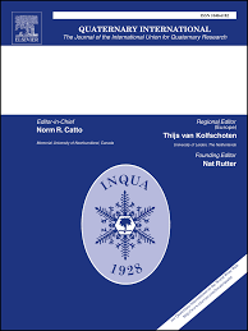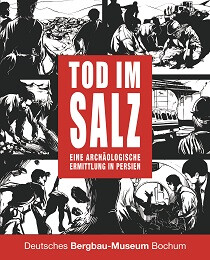Publications so far
0
| 1. |  | Maziar, Sepideh: Geographical Proximity and Material Culture; The Interplay Between Syunik and the Southern Part of the Araxes River Basin in the 6th to the 3rd Millennium BC. In: Quaternary International, iss. 579, pp. 42-58, 2021. (Type: Journal Article | Abstract | Links | BibTeX)@article{nokey,The region that is known today as Syunik in the south/southeastern part of Armenia is geographically a close neighbour of the southern part of the Araxes river basin in today Iran. Political upheavals and boundaries hindered fieldwork in these areas for many years. The archaeological project of the Araxes valley (APAV) is one of many other projects that launched in 2013 in this region and focused on the southern basin of the Araxes River. The results of the excavations of two sites, Kohne Pasgah Tepesi and Kohne Tepesi, and the intensive survey carried out in this area, enable us to shed more light on the settlement dynamics, material culture and economic/social networks of this area and its neighbours. The period from the 6th up to the middle part of the 4th millennium BC represents the Neolithic and Chalcolithic periods in this region. The material culture of both periods shares many common characteristics with contemporary traditions at sites of the southern Caucasus. Later, in the last part of the 4th millennium BC, a cultural tradition that originated in the southern Caucasus, known as the Kura-Araxes cultural tradition, expanded over a vast area, including the southern part of the Araxes river basin. Based on the study of the pottery styles and obsidian flow, the patterns of interconnection between regions, communities, and sources, and commodity flows are examined. The role of the Araxes River and its tributaries in this interplay over the stated time span is the other inquiry of this article. Furthermore, I will investigate whether spatial propinquity had any impact on commodity flows and exchange, and if so, did this impact affected the material culture and technological practices or not. |
| 2. |  | Stöllner, Thomas; Aali, Abolfazl: Long-Term Salt Mining in Chehrābād: Resilient Strategies in Accessing Mineral Resources at the Iranian Highlands. In: Pearls, Politics and Pistachios: Essays in Anthropology and Memories on the Occasion of Susan Pollock’s 65th Birthday, pp. 352-369, Ex Oriente/Propylaeum, Berlin/Heidelberg, 2021. (Type: Book Chapter | Links | BibTeX)@inbook{nokey, |
| 3. |  | Stöllner, Thomas; Aali, Abolfazl; Kashani, Natascha Bagherpour (Ed.): Tod im Salz. Eine archäologische Ermittlung in Persien. Nünnerich-Asmus Verlag & Media GmbH, 2020, ISBN: 978-3-96176-141-8. (Type: Book | Abstract | Links | BibTeX)@book{nokey,Since the first discoveries in 1993 bodies or body-parts of eight humans have been discovered at the salt-mine of Douzlākh at Chehrābād. These bodies allow a reconstruction of their lives as workers during the different operation periods. By involving many different scientific fields, it became possible to investigate their palaeo-medical aspects, their diet and their health status as well the causes of their death and their involvement into different aspects of the mining operation and logistics of the mine. It is possible not only to reconstruct three different catastrophes during the Achaemenid, the early and the late Sasanian times but also to understand the social aspects of the working people. The Achaemenid miners certainly came from abroad but already stayed a while in the region, apart from the young miner no. 4 who seems to have arrived shortly before the catastrophe. This group of migrants possibly were sent within a “bandaka”, an Achaemenid labour duty. The Sassanian miners partly came from a “regional” background but also came shortly before their deaths. Saltman 1 is interesting as he is an older individual who possibly had a special role within the miners. Mining at Douzlakh was predominantly operated in periods of strong centralized political systems when governmental activities could be organized over longer distances. |
| 4. |  | Maziar, Sepideh; Zalaghi, Ali: Exploring Beyond the River and Inside the Valleys: Settlement Development and Cultural Landscape of the Araxes River Basin Through Time. In: Iran, iss. 59, pp. 36–56, 2020. (Type: Journal Article | Abstract | Links | BibTeX)@article{nokey,Geographical landmarks, especially rivers, have always played an important role in forming or hampering interplay between societies. In some cases, they act as a “communication route” and in some others as “obstacles”. In north-western Iran, it is possible that the Araxes River played such a decisive role by sculpting its surroundings. While our studies are not yet sufficiently adequate to understand the exact role of this river in different time spans, we can begin in some way to conceptualise its role in different periods. The Araxes Valley Archaeological Project (AVAP) was developed with the general aim of investigating settlement development from the fifth to the third millennium BC. Furthermore, studying the possible and probable routes of interaction, both inter- and intra-regional, between the Jolfa and Khoda Afarin plains and the southern Caucasus and north-western Iran, networks of contacts and exchange, and gaining a better understanding of the geographical characteristics of this area and its landscape were among our aims. In this article, the general history of occupation along this river is given to provide a preliminary database to understand the geographical and socio-political potential of this part in order to pursue more comprehensive studies in the future. |
| 5. | Lamberg-Karlovsky, C. C.; Meadow, R. H.: A Unique Female Figurine: the Neolithic at Tepe Yahya. In: Archaeology, vol. 23, no. 1, pp. 12–17, 1970. (Type: Journal Article | Links | BibTeX)@article{nokey, |
2021 |
|
 | Maziar, Sepideh: Geographical Proximity and Material Culture; The Interplay Between Syunik and the Southern Part of the Araxes River Basin in the 6th to the 3rd Millennium BC. In: Quaternary International, iss. 579, pp. 42-58, 2021. (Type: Journal Article | Abstract | Links | BibTeX | Tags: Bronze Age, Chalcolithic, Economy, Kura-Araxes, Neolithic, Settlement mobility, Social, social relations, Survey)@article{nokey,The region that is known today as Syunik in the south/southeastern part of Armenia is geographically a close neighbour of the southern part of the Araxes river basin in today Iran. Political upheavals and boundaries hindered fieldwork in these areas for many years. The archaeological project of the Araxes valley (APAV) is one of many other projects that launched in 2013 in this region and focused on the southern basin of the Araxes River. The results of the excavations of two sites, Kohne Pasgah Tepesi and Kohne Tepesi, and the intensive survey carried out in this area, enable us to shed more light on the settlement dynamics, material culture and economic/social networks of this area and its neighbours. The period from the 6th up to the middle part of the 4th millennium BC represents the Neolithic and Chalcolithic periods in this region. The material culture of both periods shares many common characteristics with contemporary traditions at sites of the southern Caucasus. Later, in the last part of the 4th millennium BC, a cultural tradition that originated in the southern Caucasus, known as the Kura-Araxes cultural tradition, expanded over a vast area, including the southern part of the Araxes river basin. Based on the study of the pottery styles and obsidian flow, the patterns of interconnection between regions, communities, and sources, and commodity flows are examined. The role of the Araxes River and its tributaries in this interplay over the stated time span is the other inquiry of this article. Furthermore, I will investigate whether spatial propinquity had any impact on commodity flows and exchange, and if so, did this impact affected the material culture and technological practices or not. |
 | Stöllner, Thomas; Aali, Abolfazl: Long-Term Salt Mining in Chehrābād: Resilient Strategies in Accessing Mineral Resources at the Iranian Highlands. In: Pearls, Politics and Pistachios: Essays in Anthropology and Memories on the Occasion of Susan Pollock’s 65th Birthday, pp. 352-369, Ex Oriente/Propylaeum, Berlin/Heidelberg, 2021. (Type: Book Chapter | Links | BibTeX | Tags: Achaemenid, Administration, Bronze Age, Chalcolithic, Institutions, Iron Age, Islamic era, Minerals, Mining, Neolithic, Resilience, Resources, Salt, Sasanian, Zanjan)@inbook{nokey, |
2020 |
|
 | Stöllner, Thomas; Aali, Abolfazl; Kashani, Natascha Bagherpour (Ed.): Tod im Salz. Eine archäologische Ermittlung in Persien. Nünnerich-Asmus Verlag & Media GmbH, 2020, ISBN: 978-3-96176-141-8. (Type: Book | Abstract | Links | BibTeX | Tags: Achaemenid, Administration, Bronze Age, Chalcolithic, Institutions, Iron Age, Islamic era, Minerals, Mining, Mobility, Neolithic, Salt, Sasanian, Zanjan)@book{nokey,Since the first discoveries in 1993 bodies or body-parts of eight humans have been discovered at the salt-mine of Douzlākh at Chehrābād. These bodies allow a reconstruction of their lives as workers during the different operation periods. By involving many different scientific fields, it became possible to investigate their palaeo-medical aspects, their diet and their health status as well the causes of their death and their involvement into different aspects of the mining operation and logistics of the mine. It is possible not only to reconstruct three different catastrophes during the Achaemenid, the early and the late Sasanian times but also to understand the social aspects of the working people. The Achaemenid miners certainly came from abroad but already stayed a while in the region, apart from the young miner no. 4 who seems to have arrived shortly before the catastrophe. This group of migrants possibly were sent within a “bandaka”, an Achaemenid labour duty. The Sassanian miners partly came from a “regional” background but also came shortly before their deaths. Saltman 1 is interesting as he is an older individual who possibly had a special role within the miners. Mining at Douzlakh was predominantly operated in periods of strong centralized political systems when governmental activities could be organized over longer distances. |
 | Maziar, Sepideh; Zalaghi, Ali: Exploring Beyond the River and Inside the Valleys: Settlement Development and Cultural Landscape of the Araxes River Basin Through Time. In: Iran, iss. 59, pp. 36–56, 2020. (Type: Journal Article | Abstract | Links | BibTeX | Tags: Armenia, Azerbaijan, Bronze Age, Caucasus, Chalcolithic, Georgia, Iron Age, Kura-Araxes, Landscape, Mobility, Neolithic, Settlement and subsistance systems, Settlement mobility, Settlement structure, Structure development)@article{nokey,Geographical landmarks, especially rivers, have always played an important role in forming or hampering interplay between societies. In some cases, they act as a “communication route” and in some others as “obstacles”. In north-western Iran, it is possible that the Araxes River played such a decisive role by sculpting its surroundings. While our studies are not yet sufficiently adequate to understand the exact role of this river in different time spans, we can begin in some way to conceptualise its role in different periods. The Araxes Valley Archaeological Project (AVAP) was developed with the general aim of investigating settlement development from the fifth to the third millennium BC. Furthermore, studying the possible and probable routes of interaction, both inter- and intra-regional, between the Jolfa and Khoda Afarin plains and the southern Caucasus and north-western Iran, networks of contacts and exchange, and gaining a better understanding of the geographical characteristics of this area and its landscape were among our aims. In this article, the general history of occupation along this river is given to provide a preliminary database to understand the geographical and socio-political potential of this part in order to pursue more comprehensive studies in the future. |
1970 |
|
Lamberg-Karlovsky, C. C.; Meadow, R. H.: A Unique Female Figurine: the Neolithic at Tepe Yahya. In: Archaeology, vol. 23, no. 1, pp. 12–17, 1970. (Type: Journal Article | Links | BibTeX | Tags: Neolithic)@article{nokey, | |
